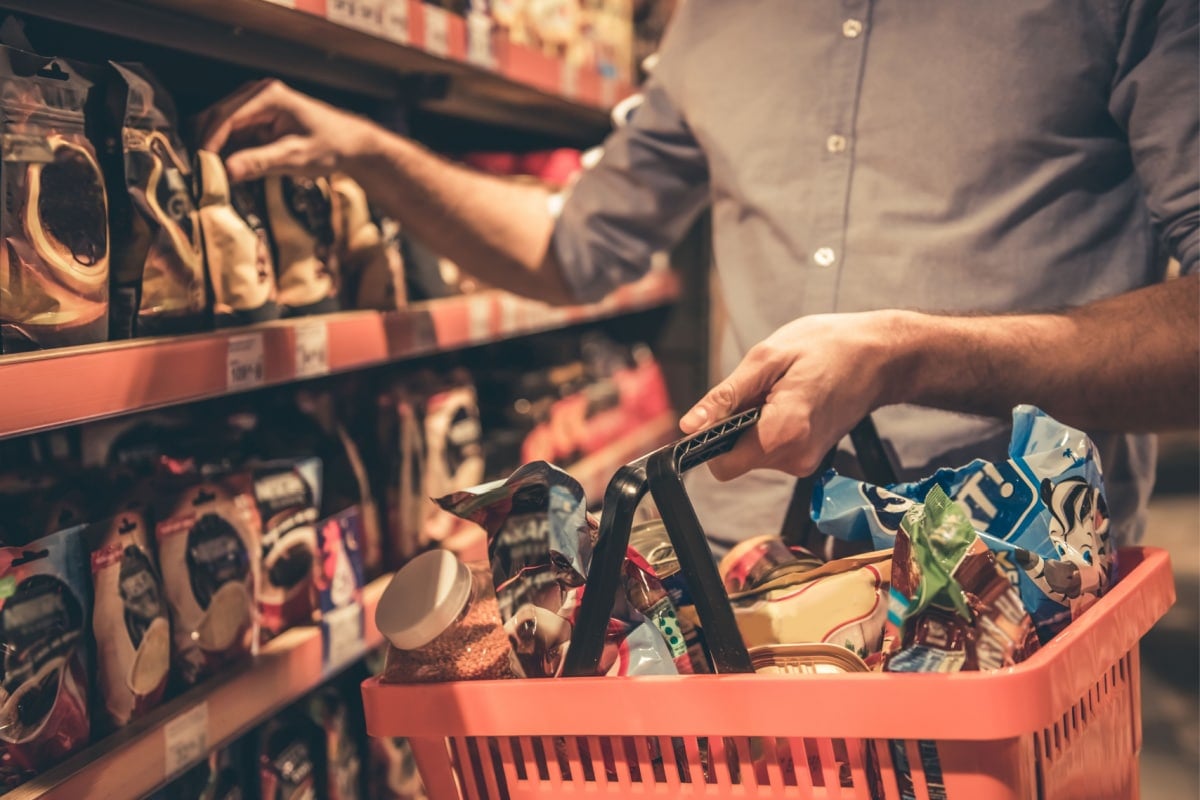Okay, can we just be honest for a sec? Have you ever thrown a mix of random items into the freezer, thinking, “Great, I’ll definitely use this later”? Freezing often feels like a smart way to save time, money, and cut down on food waste.
But then, future you opens the freezer to find a bag of mystery mush or bread that tastes like the inside of a cardboard box. Not everything handles the deep freeze like a champ, and some foods actually come out worse than when they went in. The U.S. wastes nearly 60 million tons of food every year—almost 40% of what we purchase, Recycle Track Systems (RTS), a waste company, revealed.
It’s a staggering statistic that made me realize it’s time to stop filling my freezer simply because there’s extra space. So, I started paying a little more attention to what actually freezes well and what might be happier staying fresh. These 17 foods just don’t love the cold as much as we do.
Lettuce Turns Into Sad, Slimy Slush

Because lettuce is made up of mostly water, it freezes terribly. After defrosting, what you’re left with are limp, water-logged leaves that look more like soup than salad. All its crisp texture and bright hues vanish—unless you plan to purée it into a smoothie (No judgment!), just leave it out of the freezer.
Freezing high-water-content vegetables like lettuce can cause irreversible structural damage due to the formation of large ice crystals. These crystals rupture cell walls, leading to a mushy, watery texture once thawed—definitely not ideal for a crisp salad. Simply keep your greens crisp in the fridge and eat them as soon as possible.
Cream-Based Sauces Separate Into a Mess

That luscious Alfredo? Forget about dropping it in the freezer. When you thaw a cream-based sauce, the liquids usually separate, leaving it watery and curdled.
The texture first transitions from silky-smooth to coarse-grainy, due to the separation of fat and water molecules. Reheating often intensifies the problem unless handled with care.
If you must freeze a sauce, opt for tomato-based varieties—they hold up better to the cold. Pro tip: Prepare cream sauces in small, fresh batches to capture that velvety magic every time.
Cucumbers Lose Their Cool Crispness

Putting cucumbers in the freezer is a guaranteed source of instant regret. They emerge mushy, watery, and startlingly transparent. Even when you freeze them for smoothies, the texture shift is impossible to miss.
Their 96.5% water content means that when frozen, large ice crystals form and rupture the cell walls, making them a freezer fail. Store cucumbers in the fridge, and instead of freezing any leftovers, consider pickling them instead.
Cooked Pasta Becomes a Gummy Disaster

Left on its own, plain cooked pasta simply won’t stand up to freezing. It grows gummy, lumps up, and tastes distinctly…off. If you’ve ever defrosted a container of spaghetti and wondered why it tastes like glue, now you know.
Instead, experts at ChefsResource recommend freezing the pasta with the sauce still intact to preserve both its texture and flavor. Or, even better—cook it right when you need it (it’ll only take you 10 minutes).
Whole Eggs Can Literally Explode

Yes, freezing eggs still in their shells will cause the shells to crack—and not in a fun TikTok way. As the liquid inside expands during freezing, the shell breaks and leaves a big ol’ mess. Even if they manage to stay intact, the texture turns rubbery and downright weird.
The USA Poultry & Egg Export Council advises cracking the eggs, beating them very gently, and then freezing them if you insist on storing them. If at all possible, fresh is the way to go.
Milk Gets Grainy and Weirdly Sweet

Freezing milk sounds like a terrific solution—until you actually taste it. It separates, acquires a grainy texture, and even the flavor shifts just slightly. You can shake it back together somewhat, but it’s never quite the same.
Dairy experts advise that when you’re in a hurry, you can stash milk in the freezer—only for cooking, not for drinking. Store your milk in the fridge and opt for smaller containers if it tends to spoil before you can finish it.
Sour Cream Turns Into Lumpy Soup

Once frozen, sour cream forfeits all its creamy texture. Once it’s defrosted, it turns watery and clumpy and isn’t very suitable for dolloping on tacos. By all means, you can still incorporate it into recipes but don’t anticipate it to spread or dip as smoothly as it once did.
Dairy fat does not tolerate cold temperatures very well. The refrigerator is the ideal spot for sour cream, and it typically stays fresh for up to two weeks when stored properly. A smarter strategy is to purchase smaller containers or replace the milk with Greek yogurt, a product that freezes more successfully.
Fried Foods Lose Their Crunch (and Their Charm)

Pause before storing leftover tempura or French fries in the freezer. After defrosting, they wilt, turn greasy, and forgo every ounce of crispness. The freezer turns its back on anything that was once golden and crispy.
Popping them back in the microwave won’t restore their magic, and more often than not, it just leaves them more soggy. Your best bet? Indulge them fresh, but stash the leftovers in the fridge for a reheat the next day in the microwave or air fryer.
Water-Rich Fruits Like Watermelon Get Grainy and Weird

Yes, the idea of chilled watermelon is quite inviting—until you take a bite. The texture gets mealy, and the flavor evaporates, leaving your juicy treat as nothing more than a soggy disappointment. Other water-laden fruits like oranges and grapes are no exception.
When it comes to frozen fruit snacks, berries are your unsung heroes—they freeze more reliably than any other variety. Watermelon tastes best when eaten fresh (ideally at a picnic).
Soft Cheeses Just Fall Apart

Brie, ricotta, and cream cheese just don’t hold up well when frozen. After thawing, they turn dry, crumbly, or watery. If you’re baking with them (say, a cheesecake), you might get away with freezing.
But for spreading on bagels or crackers? Nope. Soft cheeses deserve to stay cool rather than cold.
Mayo-Based Salads Turn Into Mushy Mayhem

Potato, egg, and tuna salads—freezing them practically invites texture trouble. The mayo divides, and the other ingredients become soaked and rubbery. Once defrosted, they taste nothing like the fresh original.
Mayo’s emulsion breaks down when the temperature dips. If you still have leftovers, store them in the fridge and consume them within a couple of days.
Raw Potatoes Go From Solid to Sad

According to the Idaho Potato Commission, freezing raw potatoes is strongly discouraged. The high water content in uncooked spuds causes them to turn dark, slimy, and grainy once thawed.
Instead, they recommend cooking potatoes first—whether boiling, roasting, or mashing—before freezing. So, hold off on freezing that sack of taters.
Avocados Turn Into a Slimy Science Experiment

Most of us adore avocados, but freezing them? Big mistake. They emerge with an odd texture—sticky, chewy, and just a touch brown.
Even after you mash them, they still aren’t the same. Your best bet is to eat them unfrozen or turn them into guacamole that you consume right away.
Yogurt Loses Its Silky Texture

Much like sour cream, yogurt separates in the freezer. Once thawed, it often becomes watery and grainy, even after you give it a vigorous stir. Freezing and eating it is technically safe, but the texture suffers a significant blow.
No problem if you’re popping it in the freezer for smoothie purposes. But if you intend to scoop it out for breakfast, keep it in the fridge instead.
Cream-Filled Desserts Turn Into Slush

That fancy éclair or cream puff? When you pull it from the freezer, it won’t resemble—or even taste—nearly as chic. The cream filling may split or crystallize, ruining the entire experience.
Cheesecake can likewise turn funky if it’s not wrapped just right. Fresh desserts are meant to be enjoyed, not stored indefinitely in a frosty box.
Fresh Herbs Lose Their Flavor and Structure

Cilantro, parsley, and basil alike tend to become dark and mushy when stored in the freezer. The flavor fades, the leaves soften, and what you’re left with is hardly recognizable compared with what you began with.
Though you can stash them in oil or broth and save them for later cooking, they won’t look nearly as pretty garnishing your next soup or salad. For prolonged freshness, place them in a jar filled with water and keep them in the fridge. Or dry them out the old-fashioned way!
Pastries and Croissants Just Don’t Come Back the Same

Croissants live for that melt-in-your-mouth buttery flakiness. However, once they spend time in the freezer, they resurface dense and chewy, no matter how much you reheat them.
That crisp, golden exterior is basically impossible to recreate once frozen. Fresh-baked pastries are a “treat-yourself-now” kind of food. My word—just go ahead and eat the croissant.
KEY TAKEAWAYS

- Water-heavy foods are freezer flops. Lettuce, cucumbers, watermelon, and herbs—they all turn mushy, soggy, or grainy after thawing. If it’s mostly water, it’s probably a fridge-only friend.
- Dairy doesn’t always do well in the cold. Sour cream, yogurt, milk, and soft cheeses often separate or turn gritty in the freezer. Unless you’re cooking with it later, keep it fresh or buy it in smaller portions.
- Crispy and creamy foods lose their magic. Fried foods, cream-based sauces, mayo salads, and cream-filled desserts just can’t bounce back from the freezer. They come out sad, soggy, or straight-up funky.
- When in doubt, eat it fresh or find a better storage hack. Not everything’s freezer-friendly, and that’s okay. Some things are just better enjoyed now—no icy time machine required.
Disclaimer – This list is solely the author’s opinion based on research and publicly available information. It is not intended to be professional advice.
How Total Beginners Are Building Wealth Fast in 2025—No Experience Needed

How Total Beginners Are Building Wealth Fast in 2025
I used to think investing was something you did after you were already rich. Like, you needed $10,000 in a suit pocket and a guy named Chad at some fancy firm who knew how to “diversify your portfolio.” Meanwhile, I was just trying to figure out how to stretch $43 to payday.
But a lot has changed. And fast. In 2025, building wealth doesn’t require a finance degree—or even a lot of money. The tools are simpler. The entry points are lower. And believe it or not, total beginners are stacking wins just by starting small and staying consistent.
Click here and let’s break down how.
12 Everyday Grocery Store Favorites Now Pack Banned Additives

Let me paint a picture. I was standing in the cereal aisle, scanning the shelves for my childhood favorite—those colorful little rings bursting with artificial fruit flavor. I hadn’t bought them in years, but nostalgia hit hard. Then I noticed something new on the label: “Now with no artificial dyes.”
12 Everyday Grocery Store Favorites Now Pack Banned Additives





